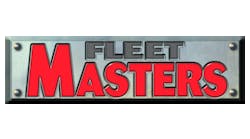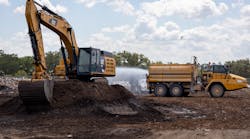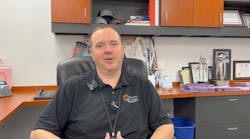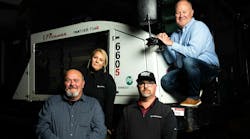In 26 years directing the operations of large equipment fleets, Dale Warner has developed systems and disciplines necessary to measure machine usage and operating severity by tracking individual units' fuel consumption. Why? Part of what he learned in 22 years as a field technician for a Caterpillar dealer was that Cat finds fuel consumption to be more effective than hours or miles of use for managing service, predicting repairs, and replacing machines.
Just a few years ago, C.J. (Buck) Miller and his sons decided they needed a fleet professional to take the precise measure of equipment costs in the Hampstead, Md., construction company's $73 million fleet. It was a benevolent coincidence that Warner had recently been turned loose by an employer of 26 years whose principals had decided to exit the construction business and was between jobs.
CJ Miller LLC Profile
Warner and Buck Miller, CJ Miller's founder, are contemporaries. Warner worked on Miller's equipment in the late 1950s and early '60s when he was a field mechanic in the Baltimore area. Now Buck is turning his business over to his sons, C.J. III, and Billy, and he couldn't ask for a more authoritative voice to advise the young men in the often-controversial area of fleet management.
"First thing I told them was, 'if you can't measure it you can't manage it,'" Warner remembers. "If we don't know exactly what our costs are, we don't know how to manage the fleet.
"First thing we did was install an equipment-maintenance management system."
Warner was a regular user of World Information Systems' ShopFax software with his previous employer's fleet, and knows a work-order-based system is the best way to gather detailed information necessary to schedule service and record cost history.
ShopFax is available as an Internet application, so the Millers could pay as they used the system. They weren't sure how equipment-management data might affect other systems such as job costing or estimating, so renting the software online was a good way to test the waters. They did not, however, limit their commitment to the technology.
"We implemented PDAs (personal digital assistants) with the technicians so they could initiate work orders and input most of their own data by scanning bar codes — started getting actual hours and costs," Warner says. "Once the techs were doing their own work orders, things kind of tightened up in shop. They were just doing a lot of 'stubby pencil' before."
That's Warner's euphemism for the rough estimates of work hours often submitted on hand-written work orders — mostly the result of undisciplined paperwork. Warner has found that the accountability imposed on technicians by creating their own electronic work orders at the time they're doing the job more than pays for the cost of the data-gathering technology.
CJ Miller technicians completed 12 percent more work orders through the first three quarters of 2006 than the same period in 2005, even while technician labor cost dropped by nearly $296,000.
Perhaps the most remarkable aspect of this labor savings is that it was accompanied by an improvement in service quality. Warner was able to hire a Cat dealer's technician late in 2005 who had been working full time in the CJ Miller shop. Bringing the additional capacity in-house and improving shop productivity with the work-order system reduced outsourcing costs by more than $423,000. At the same time, Warner's insistence on high-quality maintenance had stretched the time required to do a basic PM by two hours.
The Millers bought a high-efficiency filter cart, and are now using it to clean up the hydraulic oil in most machines during each service.
"We're definitely seeing wear go down on hydraulic systems and transmissions, according to the particle counts," Warner says of the oil-analysis results.
"Our average PM cost in 2006 was $368. In 2005, it was $253, but we did 356 less PMs in 2006 for a savings of $30,173."
Scheduling machine service based on the gallons of fuel burned, rather than hours or miles run, reduced the frequency of regular maintenance in most cases.
Fuel consumption is a more precise measure of a machine's need for service or component replacement because total gallons of fuel burned reflects much more accurately than hours or mileage just how hard the machine has worked.
CJ Miller serviced off-road machines every 200 hours and licensed vehicles at similarly conservative mileage intervals before Warner started scheduling by fuel use.
"Doing the heavy trucks by fuel burn, it's working out to about every 17,000 or 18,000 miles (it had been every 8,000 miles)," Warner says. "'Course we bring them in every 5,000 miles to grease the chassis, check brakes, and do a walk-around inspection."
Tracking the fuel consumption of pickup trucks is more difficult because their operators tend to fuel them at retail pumps, so their service intervals remain mileage based. Pickups get regular oil changes at 5,000 miles (CJ Miller had been servicing them at 3,000 miles).
Warner initiated a disciplined oil-analysis program to confirm the condition of lubricants and the components they serve. He considers oil analysis critical to support fuel-based service, and to inform decisions on replacing components before failure. Long experience with the lab at Castrol Heavy Duty, and Dryden before them, ensures that Castrol got the nod to supply lubes and do the oil analysis.
"I had them do a summary for us because I wanted to know if, through fuel scheduling, we were getting better at maintenance or not," Warner says. "The first thing we learned is that we are turning samples and getting results in about a day — it was taking 18 days to turn a sample around before. Our oil-change intervals increased more than 50 percent across the board, and at the same time component wear went down."
Of course, fuel consumption is only effective in measuring machine use if you can accurately record how much fuel each machine burns. CJ Miller overcomes this often formidable obstacle because the company operates several fuel trucks that service each machine. Fuelers record how much fuel they pump into each unit's tank, and their records keep the CJ Miller service clock running.
There's plenty of opportunity to improve the system, though, because the fuel drivers are simply recording fuel deliveries with pencil and paper. Warner is currently implementing a data-collection system called Orpak USA on all machines, vehicles and fuel trucks to nail down fuel consumption precisely.
It's an RF (radio frequency) system that requires mounting a small computer on each machine and an antenna that rings the fuel filler neck. Service trucks also get a computer and a chip in the fuel-filler nozzle. When the fueler inserts the nozzle into the filler neck, the system automatically records the time, date, gallons of fuel dispensed, the machine's run time (distinguishing between working and idling hours), and job number. The service truck's computer downloads the information via RF to the company's software where a work order is generated.
The fuel-truck computer will also gauge grease delivery, so managers will be able to confirm that an appropriate quantity of grease is delivered to each machine to properly maintain its bearings and bushings.
"It will take me six to nine months to get that system implemented on about 1,000 machines," Warner says, "But I estimate the ROI (return on investment) will be less than a year.
"Every user they've ever sold the product to has had a 6 to 8 percent improvement in fuel consumption just in reducing shrinkage," Warner says. "The system won't allow you to pump fuel unless it's in the fuel filler neck of a vehicle that has the ring in it."
"Plus, it will give us the actual time the machine ran on the job, too, which will be a huge advantage in the job-cost and estimating systems," he adds. "We'll be working with actual, true job-cost charges."
Work on administrative systems continues as CJ Miller implements Viewpoint's construction-enterprise software. Viewpoint's equipment module must be adapted to take the place of ShopFax.
"Once they got the equipment on a computer system, then they wanted to tie the information all into one system," Warner says. "While it was the groundwork for what we're doing with the fleet, in January we stopped using ShopFax. I think ShopFax is a better program for what we're doing with equipmentbecause it's a true equipment-management program, whereas Viewpoint is more accounting-based. So I'm sure there will be trade offs.
"This new system is starting to convert the equipment department into a cost center, which is something we never had before," Warner adds. "It allows us to better track costs and budget — it puts costs in place so you can measure results of your management decisions.
"The equipment-management system really focused less on cost than the new system. It would give you the cost, but you almost had to write special reports to get the information in a way that would help make decisions."
"For instance we can see whether a machine is supporting itself or not. We see that a machine is generating $10,000 per month, and whether or not the company made anything from that $10,000. The equipment program just looked at what it cost to run for the month. Normally equipment people don't get involved in that part of the business, but if you're running a cost center, you have to know that."
Warner convinced the Millers to come to AEMP's Annual Meeting in Corpus Christi to see he and his right-hand men — Fred Boog, Jeff Gist, and Tim Myerholtz — receive the Fleet Masters award. His clear objective was to share the award with the family whose confidence in him allowed the company to achieve so much in such a short time. In the heat of the moment, however, the consummate negotiator slipped into gear.
As Warner tells it, he needed to "set some terms" with his employers. The 67-year-old asked to limit his work week to four days, 5 a.m. to 4 p.m., with Fridays off.
"Since I've been here, I've been working 5 to 5 or 6 p.m., five or six days a week," Warner says. "I'm getting too old for that stuff."
Dividing the $3.5 million that Warner's policies have saved the Millers by less than three years gives you something in the neighborhood of $1.5 million in savings per year. There are still proven strategies to put in place — the fuel-management system, adapting Viewpoint to deliver work orders — so CJ Miller's rate of savings continues to accelerate.
"It is really gratifying that the owners put their trust and confidence in me to charter the course of the fleet for the coming years," Warner said.






